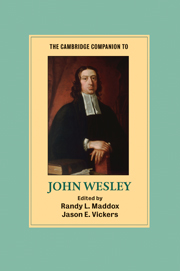Book contents
- Frontmatter
- Introduction
- Part I Wesley’s context
- Part II Wesley’s life
- Part III Wesley’s work
- 4 Wesley as revivalist/renewal leader
- 5 Wesley as preacher
- 6 Wesley as biblical interpreter
- 7 John Wesley as diarist and correspondent
- 8 John Wesley as editor and publisher
- 9 Wesley’s engagement with the natural sciences
- 10 Wesley as adviser on health and healing
- 11 Wesley’s theological emphases
- 12 Happiness, holiness, and the moral life in John Wesley
- 13 Wesley’s emphases on worship and the means of grace
- Part IV Wesley’s legacy
- Select bibliography
- Index
5 - Wesley as preacher
from Part III - Wesley’s work
Published online by Cambridge University Press: 28 September 2010
- Frontmatter
- Introduction
- Part I Wesley’s context
- Part II Wesley’s life
- Part III Wesley’s work
- 4 Wesley as revivalist/renewal leader
- 5 Wesley as preacher
- 6 Wesley as biblical interpreter
- 7 John Wesley as diarist and correspondent
- 8 John Wesley as editor and publisher
- 9 Wesley’s engagement with the natural sciences
- 10 Wesley as adviser on health and healing
- 11 Wesley’s theological emphases
- 12 Happiness, holiness, and the moral life in John Wesley
- 13 Wesley’s emphases on worship and the means of grace
- Part IV Wesley’s legacy
- Select bibliography
- Index
Summary
On October 3, 1749, Charles Wesley married Grace Murray to John Bennet. It was a devastating moment for John Wesley. Despite a host of earlier reservations about getting married, he had concluded that Grace Murray was indeed the woman for him. So much so, that he had even entered into various legal commitments to her. However, Charles had intervened and stopped any future developments in its tracks by literally carrying her off and marrying her to Bennet, a rival suitor. John worked through his distress in two ways. He wrote a moving poem that vented his suffering on God. More significantly, he returned to his work as a preacher. Such was Wesley's commitment to preaching, that one can well believe that this brought some relief amid of deep personal grief. As he noted in 1757, “About noon I preached at Woodseats, in the evening at Sheffield. I do indeed live by preaching.” Such is the legacy of preaching in his ministry that much of Methodism even to this day looks upon their ministers first and foremost as preachers. Failure in this arena spells failure overall. The legendary statistics are well known. Wesley rode up to 20,000 miles a year on horseback. He preached 800 sermons a year to crowds as large as 20,000. In a typical day he was up at 4.00 a.m., he preached at 5.00 a.m., and he was on the road to the next assignment at 6.00 a.m. Consider this neat snapshot of his work taken from Wednesday, July 21, 1779.
- Type
- Chapter
- Information
- The Cambridge Companion to John Wesley , pp. 98 - 112Publisher: Cambridge University PressPrint publication year: 2009



